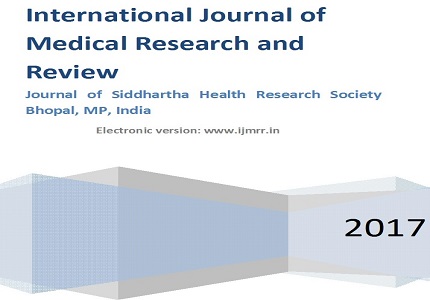A study of the correlation of non-motor symptoms of Parkinson’s disease and Parkinson plus syndrome with duration of the disease
Abstract
Introduction: Depression is common in PD, occurring in up to one-half of the patients. Anxiety disorders may be as common as depression and the two are frequently co-existent. Parkinson plus syndrome (PPS) is a group of sporadic, neurodegenerative diseases of the central nervous system, less common and usually more severe than Parkinson’s disease. They are characterised by relatively rapid disease progression and the presence of features that are atypical for PD, such as early postural instability and dementia, severe autonomic failure, or pyramidal and cerebellar signs.
Material and Methods: The study was conducted to assess the effect of duration in non-motor dysfunction in 60 patients with Parkinsonism including idiopathic Parkinson’s disease and Parkinson plus syndrome who attended either the outdoor services, or were admitted in the Neurology ward of our tertiary care centre, PGIMER & Dr. RML Hospital, New Delhi, India.
Results: PD patients had no correlation between cognition and duration of disease (p=0.079 with MMSE and p=0.145 with SCOPA COG) but had significant correlation between depression, sleep problems, pain and autonomic dysfunction with duration of disease (p=0.027, 0.008, 0.010 and 0.042 respectively).
Conclusion: Early recognition and diagnosis of PD and PPS is important as treatment may improve quality of life in patients. Co-existence of non-motor dysfunctions in the disease significantly adds to the burden of disease and affects the quality of life.
Downloads
References
Przedborski S. Etiology and pathogenesis of PD. In: Jankovic J, Tolosa E, eds. PD and Movement Disorders 5th ed. Philadelphia: Lippincott Williams and Wilkins; 2007; 77-92.
Chaudhuri KR, Martinez-Martin P, Brown RG, Sethi K, Stocchi F, Odin P, Ondo W, Abe K, Macphee G, Macmahon D, Barone P, Rabey M, Forbes A, Breen K, Tluk S, Naidu Y, Olanow W, Williams AJ, Thomas S, Rye D, Tsuboi Y, Hand A, Schapira AH. The metric properties of a novel non-motor symptoms scale for Parkinson's disease: Results from an international pilot study. Mov Disord. 2007 Oct 15;22(13):1901-11.
Delong MR, Juncos JL. PD and other extrapyramidal movement disorders. In: Fauci AS, Braunwald E, Kasper DL, Hauser SL, Longo DL, Jameson JL, et al., eds. Harrison’s principles of internal medicine 17th ed. New York (NY): The McGraw-Hill Companies 2008; 25:49-59.
Jankovic J, Shannon KM. Movement Disorders. In: Bradley WG, Daroff RB, Fenichel GM, Jankovic J, eds. Neurology in clinical practice 5th ed. Philadelphia: Butterworth-Heinemann, Elsevier; 2008;2081-122.
Mitra K, Gangopadhaya PK, Das SK. Parkinsonism plus syndrome--a review. Neurol India. 2003 Jun;51(2):183-8.
Richard IH, Schiffer RB, Kurlan R. Anxiety and Parkinson's disease. J Neuropsychiatry Clin Neurosci. 1996 Fall;8(4):383-92.
Walsh K, Bennett G. Parkinson's disease and anxiety. Postgrad Med J. 2001 Feb;77(904):89-93.
Nissenbaum H, Quinn NP, Brown RG, Toone B, Gotham AM, Marsden CD. Mood swings associated with the 'on-off' phenomenon in Parkinson's disease. Psychol Med. 1987 Nov;17(4):899-904.
Witjas T, Kaphan E, Azulay JP, Blin O, Ceccaldi M, Pouget J, Poncet M, Chérif AA. Nonmotor fluctuations in Parkinson's disease: frequent and disabling. Neurology. 2002 Aug 13;59(3):408-13.
Litvan I. Update of atypical Parkinsonian disorders. Curr Opin Neurol. 2007 Aug;20(4):434-7.
Hughes AJ, Daniel SE, Kilford L, Lees AJ. Accuracy of clinical diagnosis of idiopathic Parkinson’s disease. A clinico-pathological study of 100 cases. JNNP 1992; 55:181-184.
Steer RA, Clark DA, Beck AT, Ranieri WF. Common and specific dimensions of self-reported anxiety and depression: the BDI-II versus the BDI-IA. Behav Res Ther. 1999 Feb;37(2):183-90.
Cummings JL, Mega M, Gray K, Rosenberg-Thompson S, Carusi DA, Gornbein J. The neuropsychiatric inventory: comprehensive assessment of psychopathology in dementia. Neurology 1994;44: 2308–2314.
Schenkman ML, Clark K, Xie T, Kuchibhatla M, Shinberg M, Ray L. Spinal movement and performance of a standing reach task in participants with and without Parkinson disease. Phys Ther. 2001 Aug;81(8):1400-11.
Bassett SS. Cognitive impairment in Parkinson's disease. Clinical Focus Primary Psychiatry 2005; 12:50-55.
Reijnders JS, Ehrt U, Weber WE, Aarsland D, Leentjens AF. A systematic review of prevalence studies of depression in Parkinson's disease. Mov Disord. 2008 Jan 30;23(2):183-9; quiz 313.
Tan LC. Mood disorders in Parkinson's disease. Parkinsonism Relat Disord. 2012 Jan;18 Suppl 1:S74-6. doi: 10.1016/S1353-8020(11)70024-4.
Tandberg E, Larsen JP, Karlsen K. A community-based study of sleep disorders in patients with Parkinson's disease. Mov Disord. 1998 Nov;13(6):895-9.
Kumar S, Bhatia M, Behari M. Sleep disorders in Parkinson's disease. Mov Disord. 2002 Jul;17(4):775-81.
Tison F, Wenning GK, Volonte MA, Poewe WR, Henry P, Quinn NP. Pain in multiple system atrophy. J Neurol. 1996 Feb;243(2):153-6.
Visser M, Marinus J, Stiggelbout AM, Van Hilten JJ. Assessment of autonomic dysfunction in Parkinson's disease: the SCOPA-AUT. Mov Disord. 2004 Nov;19(11):1306-12.



 OAI - Open Archives Initiative
OAI - Open Archives Initiative


